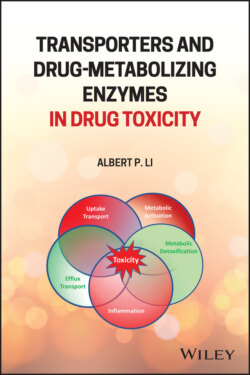Читать книгу Transporters and Drug-Metabolizing Enzymes in Drug Toxicity - Albert P. Li - Страница 93
3.12.3 Risk Factors
ОглавлениеWhile the mechanism of hepatotoxicity for troglitazone has not been fully established, experimental investigations, and correlation studies show that reactive metabolite formation and BSEP inhibition are the most likely mechanism for troglitazone‐induced liver injuries. The potential risk factors are genetic and environmental conditions that would lead to enhanced formation of metabolites (e.g. P450 induction), compromised detoxification pathways (e.g. reduced cellular GSH levels or GST activities), and sensitized cytotoxic inflammatory responses. Null mutations of GSTM1 and GSTT1 have been associated with increases in liver enzymes in troglitazone patients, suggesting the involvement reactive metabolite formation in troglitazone hepatotoxicity [228]. However, a correlation analysis between P450 isoform activities and EC50 with primary human hepatocytes from 27 donors showed that the best correlation was made not with any of the individual isoforms, but with the activity product of CYP3A4 × UGT)/SULT [229], suggesting that troglitazone is directly cytotoxic, with CYP3A4 and UGT as detoxifying and sulfotransferase (SULT) as activating activities. This correlation is consistent with the hypothesis of BSEP inhibition by troglitazone sulfate conjugates, leading to accumulation of intracellular bile salts in hepatocytes, as a key mechanism of hepatotoxicity [230]. Further, experimental evidence exists suggesting that inflammatory events may exacerbate troglitazone hepatotoxicity [231].Troglitazone‐induced liver failures represent an example where occurrence of idiosyncratic liver toxicity is a result of simultaneous occurrence of multiple sensitizing events as stated by Li’s Multiple Determinant Hypothesis [232], with the sensitizing events being enhanced metabolism of reactive metabolites (e.g. induced CYP3A4 activity), compromised GSH conjugation of reactive metabolites (e.g. reduced cellular GSH levels, reduced GST activities), enhanced sulfate formation (e.g. enhanced SULT activity), and sensitized cytotoxic immune response.
